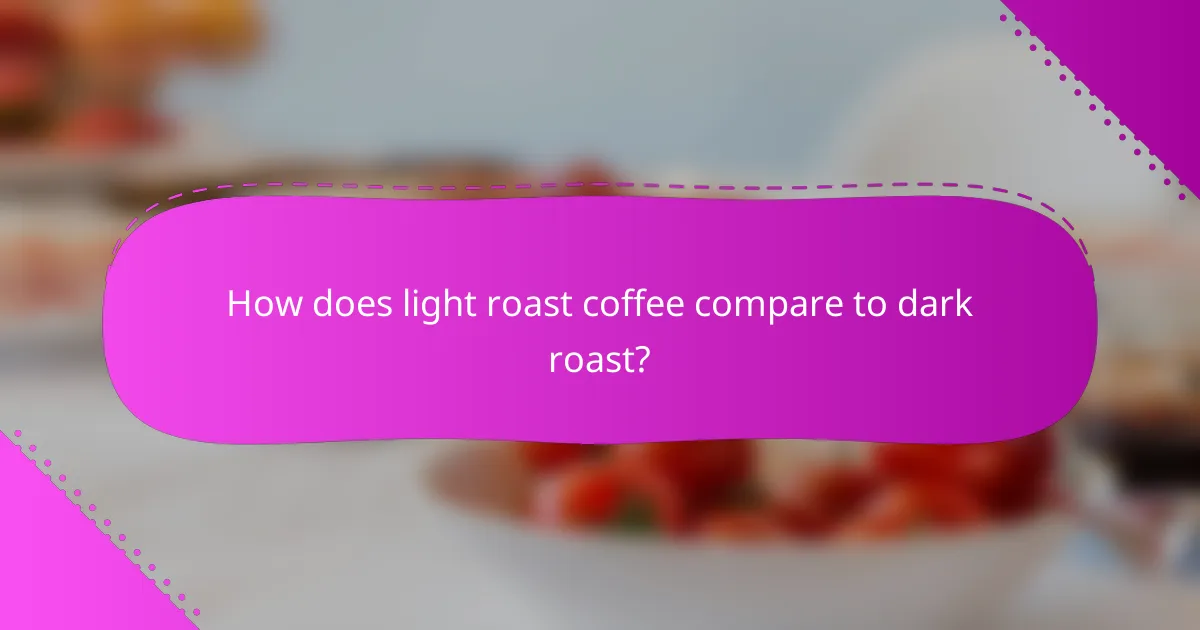Light roast coffee is celebrated for its bright acidity, floral notes, and complex flavors, offering a vibrant and nuanced tasting experience. This roast level allows the unique characteristics of the coffee beans to shine, making it a favorite among coffee enthusiasts. To fully appreciate its distinct profile, proper brewing techniques and water temperature are essential.

What are the best light roast coffee brands in New Zealand?
Some of the best light roast coffee brands in New Zealand include Allpress Espresso, Coffee Supreme, Hummingbird Coffee, Vittoria Coffee, and Ozone Coffee. These brands are known for their bright acidity, floral notes, and complex flavors, making them popular choices among coffee enthusiasts.
Allpress Espresso
Allpress Espresso is renowned for its commitment to quality and sustainability. Their light roast coffees often feature vibrant acidity and a range of floral and fruity notes, appealing to those who enjoy a bright cup. Sourcing beans from various regions, Allpress ensures a unique flavor profile in each batch.
When selecting Allpress, consider trying their single-origin offerings for a more distinct taste experience. Their blends are also well-balanced, making them versatile for different brewing methods.
Coffee Supreme
Coffee Supreme is another top contender in New Zealand’s light roast scene, known for its ethically sourced beans. Their light roasts typically showcase a clean, crisp flavor with hints of citrus and floral undertones. This brand emphasizes transparency in its sourcing practices, which resonates with conscious consumers.
For those new to light roasts, Coffee Supreme’s blends provide a great introduction, while their single-origin coffees offer a chance to explore specific flavor nuances from different growing regions.
Hummingbird Coffee
Hummingbird Coffee stands out for its artisanal approach and focus on small-batch roasting. Their light roasts are characterized by bright acidity and complex flavors, often featuring notes of berries and sweet florals. This brand prioritizes freshness, ensuring that each bag is roasted to order.
When purchasing Hummingbird Coffee, look for their seasonal offerings to experience the best flavors available at any given time. Their commitment to quality makes them a favorite among specialty coffee drinkers.
Vittoria Coffee
Vittoria Coffee is a well-established brand that offers a range of light roast options, known for their smooth and balanced profiles. Their light roasts often present a mild acidity with subtle sweetness, making them approachable for a wide audience. Vittoria emphasizes quality control throughout its roasting process.
For those who enjoy a classic coffee experience, Vittoria’s light roasts are a reliable choice. They are suitable for various brewing methods, from espresso to filter coffee.
Ozone Coffee
Ozone Coffee is celebrated for its innovative roasting techniques and commitment to sustainability. Their light roasts are vibrant and full of character, often featuring bright acidity and unique flavor notes such as tropical fruits and floral hints. Ozone sources its beans from sustainable farms, ensuring ethical practices.
When exploring Ozone Coffee, consider their tasting flights, which allow you to sample different light roasts side by side. This can enhance your understanding of flavor profiles and help you find your favorite.

How to brew light roast coffee for optimal flavor?
To brew light roast coffee for optimal flavor, focus on using the right method and water temperature to highlight its bright acidity and floral notes. Each brewing technique can enhance different aspects of the coffee’s complex flavors, so choose one that suits your taste preferences.
Pour-over method
The pour-over method allows for precise control over brewing time and water flow, which is essential for extracting the unique flavors of light roast coffee. Use a medium-fine grind and water heated to around 90-96°C (194-205°F) to maintain the coffee’s brightness.
Start by blooming the coffee with a small amount of water, letting it sit for about 30 seconds before continuing to pour in a circular motion. Aim for a total brew time of 2-3 minutes for optimal extraction.
French press technique
The French press method produces a fuller body but can sometimes mute the brightness of light roast coffee. Use a coarse grind and water heated to about 90-94°C (194-201°F) to preserve the coffee’s delicate flavors.
Let the coffee steep for about 4 minutes before pressing down the plunger slowly. Pour immediately to avoid over-extraction, which can lead to bitterness.
Aeropress brewing
The Aeropress is versatile and can produce a clean cup with bright acidity, making it suitable for light roast coffee. Use a medium grind and water heated to around 85-90°C (185-194°F) for best results.
Experiment with different brewing times, typically between 1-2 minutes, and try the inverted method for a richer flavor. After brewing, press the coffee gently to avoid bitterness, and enjoy the vibrant notes of your light roast.

What are the flavor profiles of light roast coffee?
Light roast coffee is characterized by its bright acidity, floral notes, and complex flavors. These profiles create a vibrant cup that highlights the unique characteristics of the coffee beans.
Bright acidity
Bright acidity in light roast coffee refers to the crisp, tangy flavor that can be reminiscent of citrus or green apple. This acidity is a key feature, providing a refreshing quality that balances the sweetness of the coffee.
When selecting light roast coffee, look for beans that showcase this brightness, as it can enhance the overall tasting experience. Popular varieties known for their bright acidity include Ethiopian and Kenyan coffees.
Floral notes
Floral notes in light roast coffee often present as delicate aromas and flavors, such as jasmine or lavender. These notes contribute to the complexity and appeal of the coffee, making it a favorite among those who enjoy nuanced tastes.
To identify floral notes, consider brewing methods that highlight these characteristics, such as pour-over or Aeropress. Freshly roasted beans will typically offer more pronounced floral aromas, so opt for recently sourced coffees.
Complex flavors
Complex flavors in light roast coffee encompass a wide range of tastes, from fruity to herbal, often layered within a single cup. This complexity arises from the roasting process, which preserves the natural flavors of the beans.
When tasting light roast coffee, pay attention to the evolving flavors as you sip. Experiment with different brewing techniques and water temperatures to uncover the full spectrum of flavors, and consider trying single-origin coffees for a more distinct experience.

What are the health benefits of light roast coffee?
Light roast coffee offers several health benefits, primarily due to its higher antioxidant content and lower caffeine levels compared to darker roasts. These characteristics can contribute to improved overall health and well-being when consumed in moderation.
Higher antioxidant levels
Light roast coffee is known for its elevated levels of antioxidants, which help combat oxidative stress in the body. Antioxidants play a crucial role in neutralizing free radicals, potentially reducing the risk of chronic diseases such as heart disease and cancer.
Studies suggest that light roasts may contain up to 30% more antioxidants than darker varieties. This makes them a favorable choice for those looking to maximize their intake of beneficial compounds while enjoying their daily cup of coffee.
Lower caffeine content
Light roast coffee typically has lower caffeine content compared to darker roasts, making it a suitable option for individuals sensitive to caffeine. While the difference may not be drastic, light roasts can contain about 10-20% less caffeine, which can help mitigate jitters or anxiety for some drinkers.
For those who enjoy multiple cups throughout the day, choosing a light roast can allow for a more balanced caffeine intake. This can be particularly beneficial for people who want to enjoy coffee without the risk of overconsumption of caffeine.

How does light roast coffee compare to dark roast?
Light roast coffee is known for its bright acidity and complex flavors, contrasting sharply with the bold, smoky notes of dark roast. While light roasts preserve more of the coffee bean’s original characteristics, dark roasts tend to emphasize the roasting process, resulting in a heavier body and reduced acidity.
Flavor differences
Light roast coffee typically features floral notes and fruity undertones, offering a more nuanced taste profile. In contrast, dark roast coffee has a richer, more robust flavor, often with chocolatey or caramelized notes. The lighter roasting process allows for a greater expression of the bean’s origin, making it ideal for those who appreciate subtlety in their coffee.
For example, a light roast from Ethiopia may present citrus and berry flavors, while a dark roast from Brazil might showcase nutty and chocolatey characteristics. This diversity in flavor is one of the key reasons coffee enthusiasts often prefer light roasts.
Caffeine levels
Contrary to popular belief, light roast coffee generally contains slightly more caffeine than dark roast. The roasting process breaks down caffeine, so lighter roasts, which are roasted for a shorter time, retain more of it. However, the difference in caffeine content is usually minimal, often just a few milligrams per cup.
If you’re looking for a caffeine boost, a light roast might be the better choice, especially if you enjoy its bright and complex flavors. Keep in mind that brewing methods can also influence caffeine extraction, so consider your preparation technique.
Acidity levels
Light roast coffee is characterized by its higher acidity, which contributes to its bright and vibrant flavor profile. This acidity can enhance the overall tasting experience, making the coffee feel more refreshing. Dark roasts, on the other hand, have lower acidity due to the longer roasting time, which mellows out the sharpness.
For those sensitive to acidity, dark roast may be a more suitable option. However, many coffee drinkers appreciate the lively acidity of light roasts, especially when paired with certain foods or enjoyed as a morning pick-me-up.

What are the best brewing temperatures for light roast coffee?
The optimal brewing temperature for light roast coffee typically ranges from 195°F to 205°F (90°C to 96°C). This temperature range helps to extract the bright acidity and floral notes characteristic of light roasts without over-extracting bitter flavors.
Why is brewing temperature important for light roast coffee?
Brewing temperature significantly affects the extraction of flavors in light roast coffee. Higher temperatures can lead to over-extraction, resulting in a bitter taste, while lower temperatures may under-extract, causing the coffee to taste flat or sour. Finding the right balance is essential for achieving the desired complexity and brightness.
What are the best methods for measuring brewing temperature?
Using a thermometer is the most accurate way to measure brewing temperature. Digital thermometers provide quick readings, while dial thermometers may take longer but can still be effective. Alternatively, many modern coffee makers come with built-in temperature controls that can help maintain the ideal brewing temperature.
How can you adjust brewing temperature for different light roast coffees?
Different light roast coffees may require slight adjustments in brewing temperature based on their unique flavor profiles. For instance, if a coffee has pronounced floral notes, brewing at the lower end of the range (around 195°F) may enhance those flavors. Conversely, if the coffee has a more complex flavor, brewing closer to 205°F can help bring out additional nuances.
